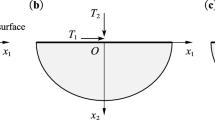Synopsis
An experimental method is investigated by which the elastic-plastic boundaries of a rectangular tapered beam having a single concentrated load acting at its free end can be determined. The method, based on the Tresca yield criterion, employs the isochromatics of the photoelastic stress pattern in birefringent coatings and is used to locate experimentally the elastic-plastic boundaries in a series of aluminum beams of small angles of taper. To check these boundary locations theoretically, the simple mechanics-of-materials elastic-plastic beam theory is used, and the comparisons of theoretical and experimental results are shown.
It is believed that the theoretical-experimental correlation is shown to be sufficiently close to indicate that the method presented is useful in determining the elastic-plastic boundaries in those problems which do not readily lend themselves to solution by analytical means.
Similar content being viewed by others
Bibliography
Dixon, J. R., andVisser, W., “An Investigation of the Elastic-Plastic Strain Distribution around Cracks in Various Sheet Materials,”Photoelasticity (Proc. Intl. Symp., Chicago, Ill., 1961),Edited by M. M. Frocht, The Macmillan Co., New York, 231–250 (1963).
Duffy, J., “Effects of the Thickness of Birefringent Coatings,”Experimental Mechanics,1 (3),74–82 (1961).
Lee, T. C., Mylonas, C., andDuffy, J., “Thickness Effects in Birefringent Coatings with Radial Symmetry,”,1 (10),134–141 (1961).
Kawata, K., “Elastoplastic Stress Analysis and Determination of Flow Limit by Means of Photoelastic Coating Method,”Photoelasticity (Proc. Intl. Symp., Chicago, Ill., 1961),Edited by M. M. Frocht, The Macmillan Co., New York, 219–230 (1963).
Theocaris, P. S., andMarketos, E., “Elastic-Plastic Strain and Stress Distribution in Notched Plates under Plane Stress,”Jnl. Mech. and Phys. of Solids,11 (6),411–428 (1963).
Gerberich, W. W., “Stress Distribution About a Slowly Growing Crack Determined by Photoelastic-coating Method,”Experimental Mechanics,2 (12),359–365 (1962).
Gerberich, W. W., “Plastic Strains and Energy Density in Cracked Plates Part 1,”,4 (11),335–344 (1964).
Naghdi, P. M., “Stresses and Displacements in an Elastic-Plastic Wedge,”Jnl. Appl. Mech., ASME Trans.,79,98–104 (1957).
Bland, D. R., andNaghdi, P. M., “A Compressible Elastic, Perfectly Plastic Wedge,”,80,239–242 (1958).
Murch, S. A., and Naghdi, P. M., “On the Infinite Elastic, Perfectly Plastic Wedge under Uniform Surface Tractions,” Proc. 3rd U. S. Natl. Congr. Appl. Mech., ASME, New York, 611–624 (1958).
Naghdi, P. M., “On Plane Stress Solution of An Elastic, Perfectly Plastic Wedge,”Jnl. Appl. Mech., ASME Trans.,80,407–410 (1958).
Rogers, B. G., “Plastic Analysis and Design of Non-Prismatic Members,” Ph.D. thesis, University of Illinois (May 1961).
Hamzawi, H. H., “Plastic Analysis of Non-Prismatic Members,” Ph.D. thesis, Stanford University (Aug. 1957).
Steele, M. C., and Hassan, H. A., “The Effects of Inelastic Action on the Resistance to Various Types of Loads of Ductile Materials Made from Various Classes of Metals, Part III: The Plastic Bending of Tapered Members,” WADC Tech. Rpt. 56-330, pt III, Cont. No. AF 33(616)-2753, Proj. No. 7360 (Apr. 1956).
Valpey, R. G., “Location of the Elastic-Plastic Boundary in Tapered Beams Subjected to Point Loads,” Ph.D. thesis, University of Illinois (June 1962).
Mesnager, M., “Sur la Détermination Optique des Tensions Intérieures dans les Solides à Trois Dimensions,”Comptes Rendus Hebdomadaires des Séances de l'Académie des Sciences,190,1249,1250 (Jan.–June 1930).
D'Agostino, J., Drucker, D. C., Liu, C. K., andMylonas, C., “An Analysis of Plastic Behavior of Metals with Bonded Birefringent Plastic,”Proc. SESA, XII (2),115–122 (1955).
D'Agostino, J., Drucker, D. C., Liu, C. K., andMylonas, C., Epoxy Adhesives and Casting Resins as Photoelastic Plastics,”,123–128.
Calcote, L. R., “Elastic-Plastic Analysis of Tapered Beams Subjected to Point Loads,” Ph.D. thesis, University of Illinois (Oct., 1963).
Steele, M. C., “Partially Plastic Thick-Walled Cylinders,” WADC Cont. No. AF 33 (038)-15677, University of Illinois, Engrg. Expt. Sta. (Feb. 1952).
Author information
Authors and Affiliations
Additional information
Paper is based on a part of the Ph.D. thesis, Theoretical and Applied Mechanics Department, University of Illinois, Urbana, Ill.
Rights and permissions
About this article
Cite this article
Calcote, L.R., Bowman, C.E. Experimental determination of the elastic-plastic boundary. Experimental Mechanics 5, 262–266 (1965). https://doi.org/10.1007/BF02327150
Issue Date:
DOI: https://doi.org/10.1007/BF02327150




